oil pressure CHEVROLET DURAMAX 2006 Owners Manual
[x] Cancel search | Manufacturer: CHEVROLET, Model Year: 2006, Model line: DURAMAX, Model: CHEVROLET DURAMAX 2006Pages: 100, PDF Size: 0.71 MB
Page 5 of 100
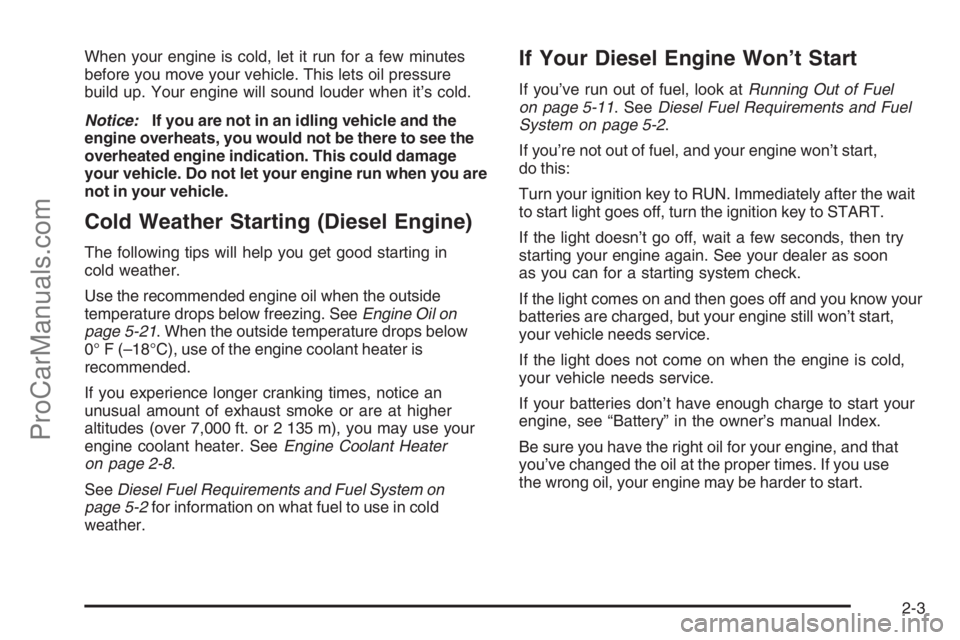
When your engine is cold, let it run for a few minutes
before you move your vehicle. This lets oil pressure
build up. Your engine will sound louder when it’s cold.
Notice:If you are not in an idling vehicle and the
engine overheats, you would not be there to see the
overheated engine indication. This could damage
your vehicle. Do not let your engine run when you are
not in your vehicle.
Cold Weather Starting (Diesel Engine)
The following tips will help you get good starting in
cold weather.
Use the recommended engine oil when the outside
temperature drops below freezing. SeeEngine Oil on
page 5-21. When the outside temperature drops below
0° F (–18°C), use of the engine coolant heater is
recommended.
If you experience longer cranking times, notice an
unusual amount of exhaust smoke or are at higher
altitudes (over 7,000 ft. or 2 135 m), you may use your
engine coolant heater. SeeEngine Coolant Heater
on page 2-8.
SeeDiesel Fuel Requirements and Fuel System on
page 5-2for information on what fuel to use in cold
weather.
If Your Diesel Engine Won’t Start
If you’ve run out of fuel, look atRunning Out of Fuel
on page 5-11. SeeDiesel Fuel Requirements and Fuel
System on page 5-2.
If you’re not out of fuel, and your engine won’t start,
do this:
Turn your ignition key to RUN. Immediately after the wait
to start light goes off, turn the ignition key to START.
If the light doesn’t go off, wait a few seconds, then try
starting your engine again. See your dealer as soon
as you can for a starting system check.
If the light comes on and then goes off and you know your
batteries are charged, but your engine still won’t start,
your vehicle needs service.
If the light does not come on when the engine is cold,
your vehicle needs service.
If your batteries don’t have enough charge to start your
engine, see “Battery” in the owner’s manual Index.
Be sure you have the right oil for your engine, and that
you’ve changed the oil at the proper times. If you use
the wrong oil, your engine may be harder to start.
2-3
ProCarManuals.com
Page 13 of 100
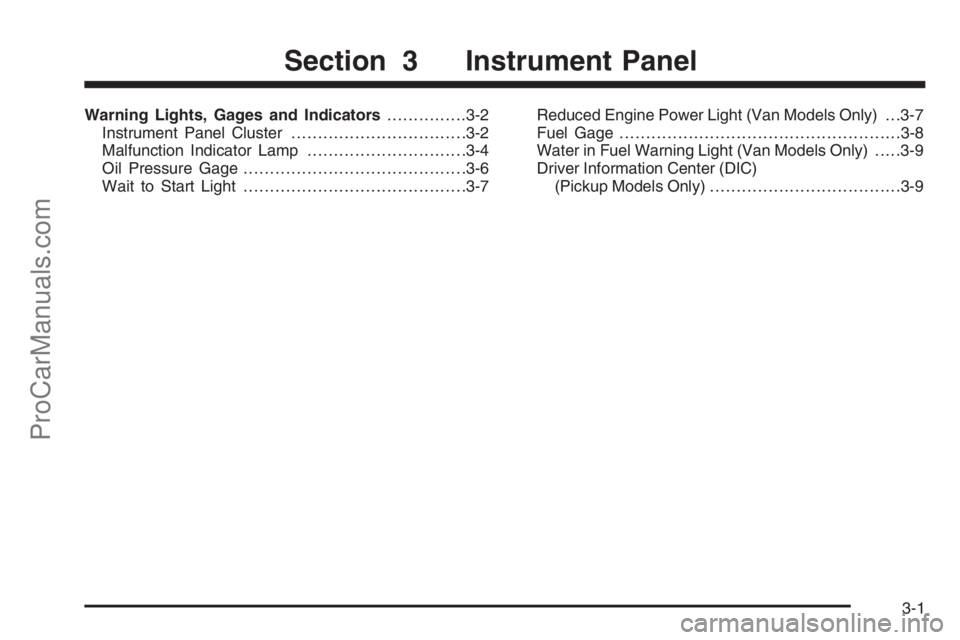
Warning Lights, Gages and Indicators...............3-2
Instrument Panel Cluster.................................3-2
Malfunction Indicator Lamp..............................3-4
Oil Pressure Gage..........................................3-6
Wait to Start Light..........................................3-7Reduced Engine Power Light (Van Models Only) . . .3-7
Fuel Gage.....................................................3-8
Water in Fuel Warning Light (Van Models Only).....3-9
Driver Information Center (DIC)
(Pickup Models Only)....................................3-9
Section 3 Instrument Panel
3-1
ProCarManuals.com
Page 18 of 100
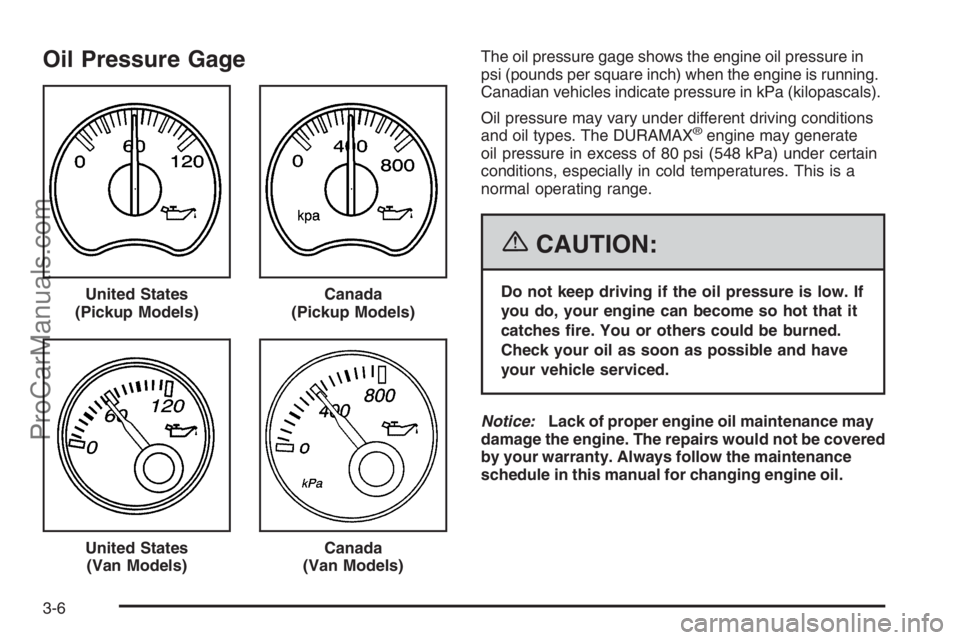
Oil Pressure GageThe oil pressure gage shows the engine oil pressure in
psi (pounds per square inch) when the engine is running.
Canadian vehicles indicate pressure in kPa (kilopascals).
Oil pressure may vary under different driving conditions
and oil types. The DURAMAX
®engine may generate
oil pressure in excess of 80 psi (548 kPa) under certain
conditions, especially in cold temperatures. This is a
normal operating range.
{CAUTION:
Do not keep driving if the oil pressure is low. If
you do, your engine can become so hot that it
catches �re. You or others could be burned.
Check your oil as soon as possible and have
your vehicle serviced.
Notice:Lack of proper engine oil maintenance may
damage the engine. The repairs would not be covered
by your warranty. Always follow the maintenance
schedule in this manual for changing engine oil. United States
(Pickup Models)Canada
(Pickup Models)
United States
(Van Models)Canada
(Van Models)
3-6
ProCarManuals.com
Page 25 of 100

Diesel Fuel Requirements and Fuel System.......5-2
Diesel Engine Fuel.........................................5-2
What Fuel to Use...........................................5-3
Very Cold Weather Operation...........................5-5
Water in Fuel.................................................5-5
Water in Fuel Light Chart................................5-6
Running Out of Fuel.....................................5-11
Fuel Filter Replacement.................................5-12
Filling the Tank............................................5-15
Filling a Portable Fuel Container.....................5-17Checking Things Under the Hood....................5-18
Engine Compartment Overview.......................5-18
Engine Oil...................................................5-21
Engine Oil Life System..................................5-24
Engine Air Cleaner/Filter................................5-25
Automatic Transmission Fluid.........................5-29
Engine Coolant.............................................5-34
Radiator Pressure Cap..................................5-39
Coolant Surge Tank Pressure Cap..................5-39
Engine Overheating.......................................5-39
Cooling System............................................5-41
Capacities and Speci�cations..........................5-50
Specification Charts......................................5-50
Section 5 Service and Appearance Care
5-1
ProCarManuals.com
Page 65 of 100

If you get the overheat warning with no sign of steam,
try this for a minute or so:
1. In heavy traffic, let the engine idle in NEUTRAL (N)
while stopped. If it is safe to do so, pull off the road,
shift to PARK (P) or NEUTRAL (N), and let the
engine idle.
2. Turn on your heater to full hot at the highest fan
speed and open the window as necessary.
If you no longer have the overheat warning, you can
drive. Just to be safe, drive slower for about 10 minutes.
If the warning doesn’t come back on, you can drive
normally.
If the warning continues, pull over, stop, and park your
vehicle right away.
If there’s still no sign of steam and your vehicle is
equipped with an engine driven cooling fan, push down
the accelerator until the engine speed is about twice as
fast as normal idle speed for at least three minutes while
you’re parked. If there is no sign of steam and your
vehicle is equipped with an electric cooling fan, idle the
engine for three minutes while you’re parked. If you still
have the warning,turn off the engine and get everyone
out of the vehicleuntil it cools down.
You may decide not to lift the hood but to get service
help right away.Cooling System
Pickup Models
When you decide it’s safe to lift the hood, here’s what
you’ll see:
A. Coolant Surge Tank Pressure Cap
B. Coolant Surge Tank
C. Engine Fan
If the coolant inside the coolant surge tank is boiling,
don’t do anything else until it cools down. The vehicle
should be parked on a level surface.
5-41
ProCarManuals.com
Page 67 of 100
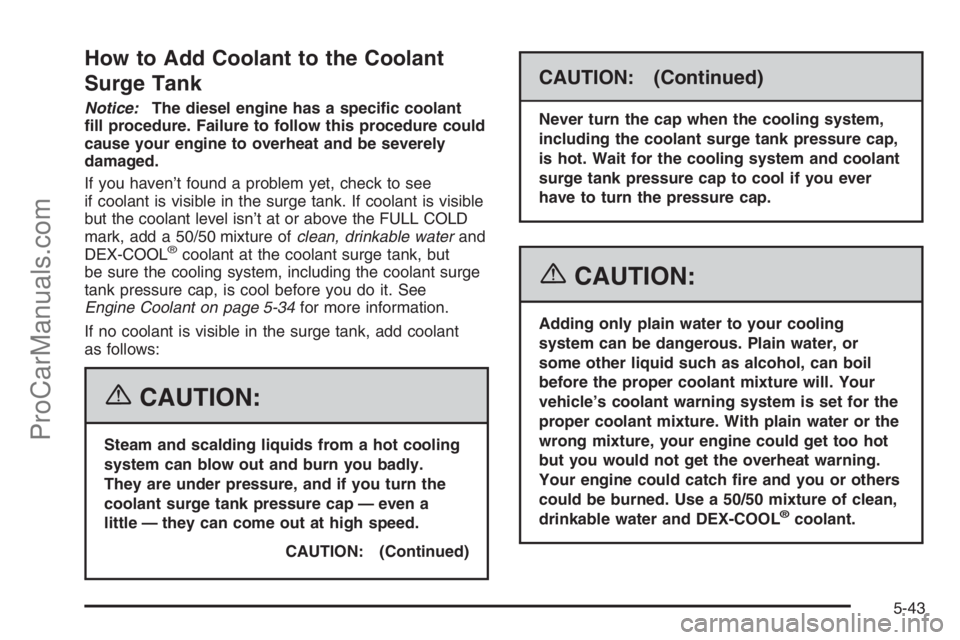
How to Add Coolant to the Coolant
Surge Tank
Notice:The diesel engine has a speci�c coolant
�ll procedure. Failure to follow this procedure could
cause your engine to overheat and be severely
damaged.
If you haven’t found a problem yet, check to see
if coolant is visible in the surge tank. If coolant is visible
but the coolant level isn’t at or above the FULL COLD
mark, add a 50/50 mixture ofclean, drinkable waterand
DEX-COOL
®coolant at the coolant surge tank, but
be sure the cooling system, including the coolant surge
tank pressure cap, is cool before you do it. See
Engine Coolant on page 5-34for more information.
If no coolant is visible in the surge tank, add coolant
as follows:
{CAUTION:
Steam and scalding liquids from a hot cooling
system can blow out and burn you badly.
They are under pressure, and if you turn the
coolant surge tank pressure cap — even a
little — they can come out at high speed.
CAUTION: (Continued)
CAUTION: (Continued)
Never turn the cap when the cooling system,
including the coolant surge tank pressure cap,
is hot. Wait for the cooling system and coolant
surge tank pressure cap to cool if you ever
have to turn the pressure cap.
{CAUTION:
Adding only plain water to your cooling
system can be dangerous. Plain water, or
some other liquid such as alcohol, can boil
before the proper coolant mixture will. Your
vehicle’s coolant warning system is set for the
proper coolant mixture. With plain water or the
wrong mixture, your engine could get too hot
but you would not get the overheat warning.
Your engine could catch �re and you or others
could be burned. Use a 50/50 mixture of clean,
drinkable water and DEX-COOL
®coolant.
5-43
ProCarManuals.com
Page 70 of 100
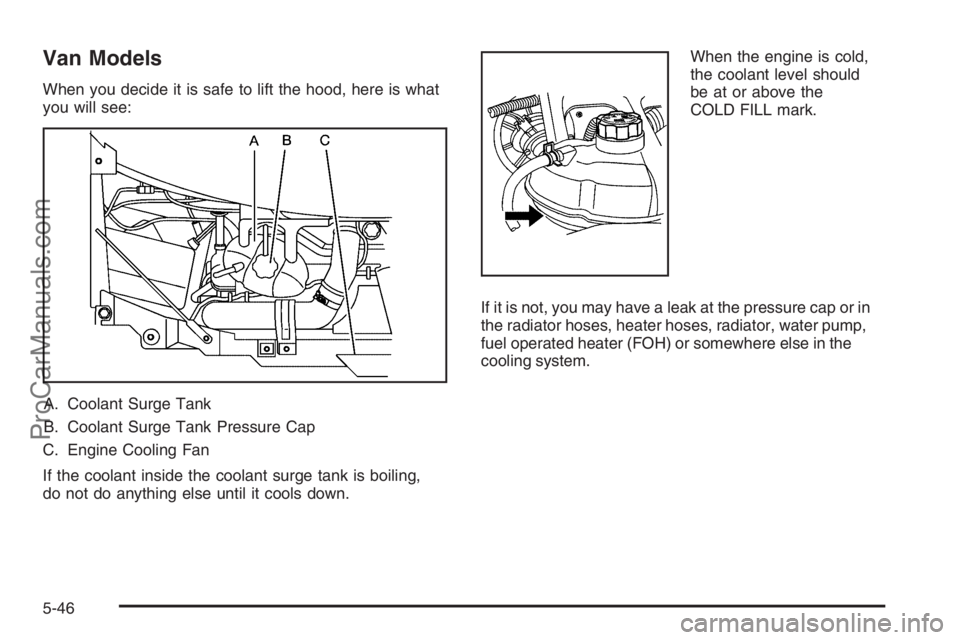
Van Models
When you decide it is safe to lift the hood, here is what
you will see:
A. Coolant Surge Tank
B. Coolant Surge Tank Pressure Cap
C. Engine Cooling Fan
If the coolant inside the coolant surge tank is boiling,
do not do anything else until it cools down.When the engine is cold,
the coolant level should
be at or above the
COLD FILL mark.
If it is not, you may have a leak at the pressure cap or in
the radiator hoses, heater hoses, radiator, water pump,
fuel operated heater (FOH) or somewhere else in the
cooling system.
5-46
ProCarManuals.com
Page 72 of 100
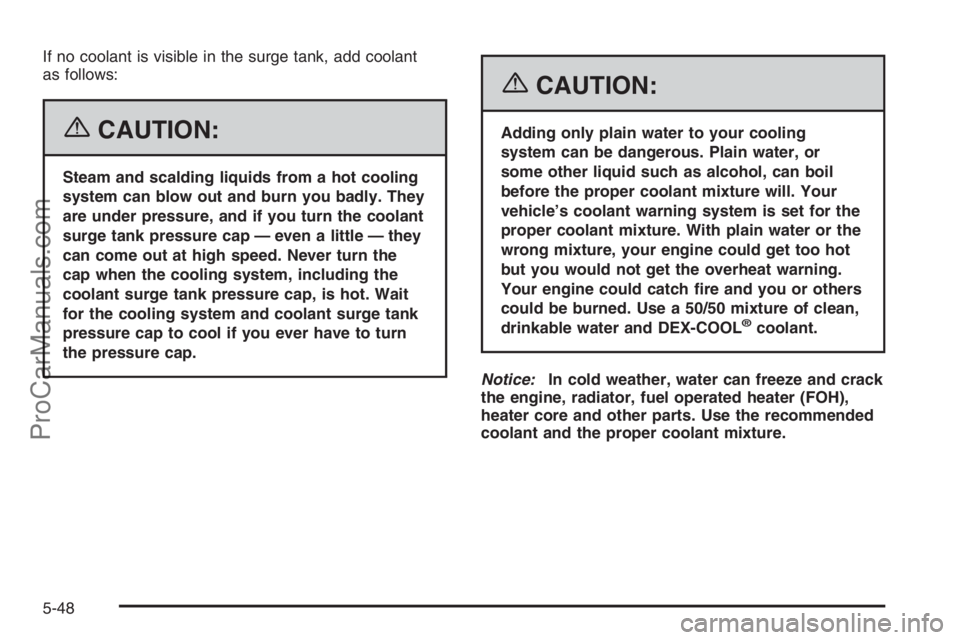
If no coolant is visible in the surge tank, add coolant
as follows:
{CAUTION:
Steam and scalding liquids from a hot cooling
system can blow out and burn you badly. They
are under pressure, and if you turn the coolant
surge tank pressure cap — even a little — they
can come out at high speed. Never turn the
cap when the cooling system, including the
coolant surge tank pressure cap, is hot. Wait
for the cooling system and coolant surge tank
pressure cap to cool if you ever have to turn
the pressure cap.
{CAUTION:
Adding only plain water to your cooling
system can be dangerous. Plain water, or
some other liquid such as alcohol, can boil
before the proper coolant mixture will. Your
vehicle’s coolant warning system is set for the
proper coolant mixture. With plain water or the
wrong mixture, your engine could get too hot
but you would not get the overheat warning.
Your engine could catch �re and you or others
could be burned. Use a 50/50 mixture of clean,
drinkable water and DEX-COOL
®coolant.
Notice:In cold weather, water can freeze and crack
the engine, radiator, fuel operated heater (FOH),
heater core and other parts. Use the recommended
coolant and the proper coolant mixture.
5-48
ProCarManuals.com
Page 79 of 100
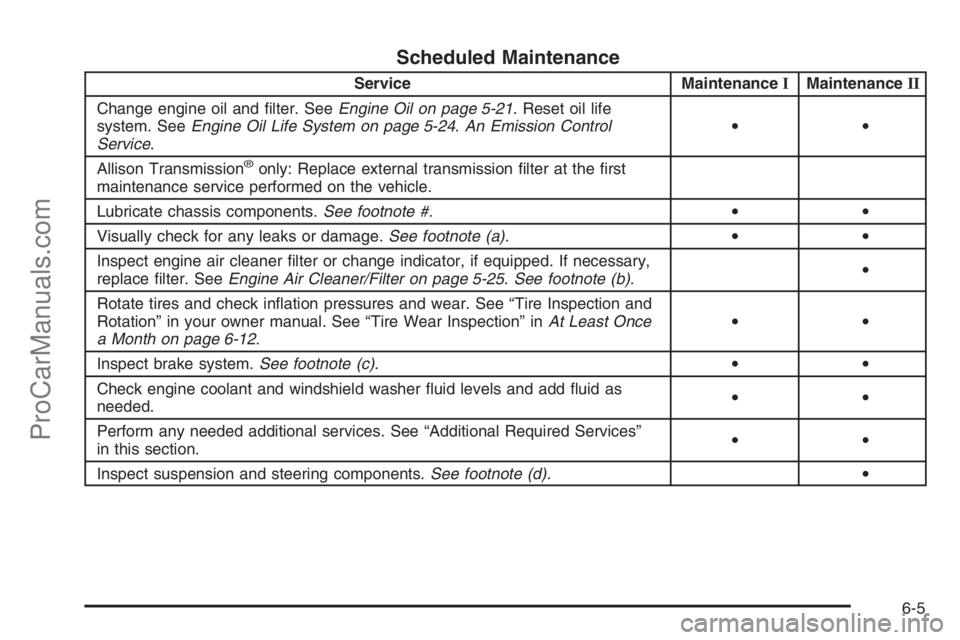
Scheduled Maintenance
Service MaintenanceIMaintenanceII
Change engine oil and filter. SeeEngine Oil on page 5-21. Reset oil life
system. SeeEngine Oil Life System on page 5-24.An Emission Control
Service.••
Allison Transmission
®only: Replace external transmission filter at the first
maintenance service performed on the vehicle.
Lubricate chassis components.See footnote #.••
Visually check for any leaks or damage.See footnote (a).••
Inspect engine air cleaner filter or change indicator, if equipped. If necessary,
replace filter. SeeEngine Air Cleaner/Filter on page 5-25.See footnote (b).•
Rotate tires and check inflation pressures and wear. See “Tire Inspection and
Rotation” in your owner manual. See “Tire Wear Inspection” inAt Least Once
a Month on page 6-12.••
Inspect brake system.See footnote (c).••
Check engine coolant and windshield washer fluid levels and add fluid as
needed.••
Perform any needed additional services. See “Additional Required Services”
in this section.••
Inspect suspension and steering components.See footnote (d).•
6-5
ProCarManuals.com
Page 83 of 100
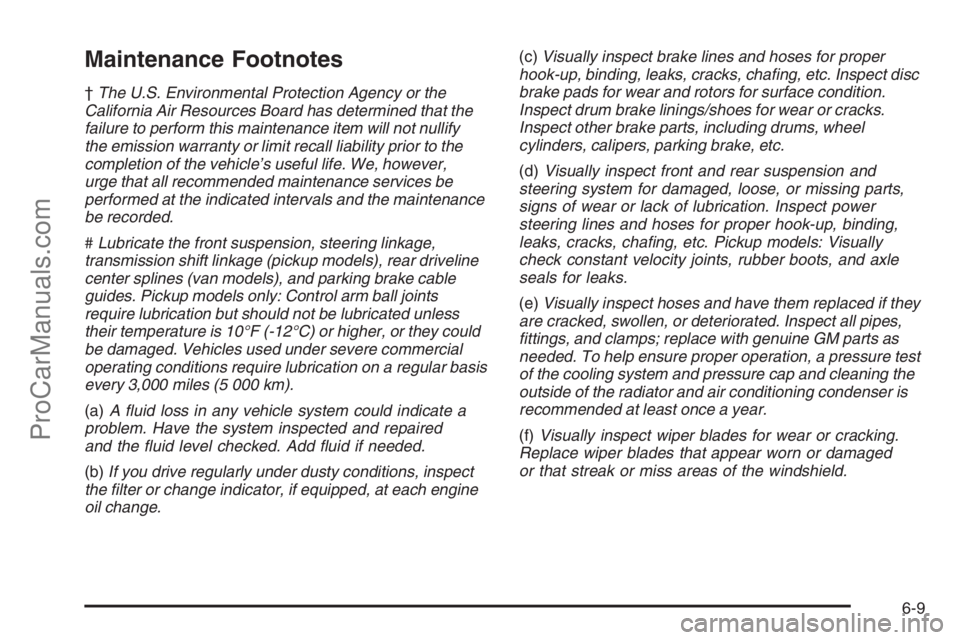
Maintenance Footnotes
†The U.S. Environmental Protection Agency or the
California Air Resources Board has determined that the
failure to perform this maintenance item will not nullify
the emission warranty or limit recall liability prior to the
completion of the vehicle’s useful life. We, however,
urge that all recommended maintenance services be
performed at the indicated intervals and the maintenance
be recorded.
#Lubricate the front suspension, steering linkage,
transmission shift linkage (pickup models), rear driveline
center splines (van models), and parking brake cable
guides. Pickup models only: Control arm ball joints
require lubrication but should not be lubricated unless
their temperature is 10°F (-12°C) or higher, or they could
be damaged. Vehicles used under severe commercial
operating conditions require lubrication on a regular basis
every 3,000 miles (5 000 km).
(a)A �uid loss in any vehicle system could indicate a
problem. Have the system inspected and repaired
and the �uid level checked. Add �uid if needed.
(b)If you drive regularly under dusty conditions, inspect
the �lter or change indicator, if equipped, at each engine
oil change.(c)Visually inspect brake lines and hoses for proper
hook-up, binding, leaks, cracks, cha�ng, etc. Inspect disc
brake pads for wear and rotors for surface condition.
Inspect drum brake linings/shoes for wear or cracks.
Inspect other brake parts, including drums, wheel
cylinders, calipers, parking brake, etc.
(d)Visually inspect front and rear suspension and
steering system for damaged, loose, or missing parts,
signs of wear or lack of lubrication. Inspect power
steering lines and hoses for proper hook-up, binding,
leaks, cracks, cha�ng, etc. Pickup models: Visually
check constant velocity joints, rubber boots, and axle
seals for leaks.
(e)Visually inspect hoses and have them replaced if they
are cracked, swollen, or deteriorated. Inspect all pipes,
�ttings, and clamps; replace with genuine GM parts as
needed. To help ensure proper operation, a pressure test
of the cooling system and pressure cap and cleaning the
outside of the radiator and air conditioning condenser is
recommended at least once a year.
(f)Visually inspect wiper blades for wear or cracking.
Replace wiper blades that appear worn or damaged
or that streak or miss areas of the windshield.
6-9
ProCarManuals.com